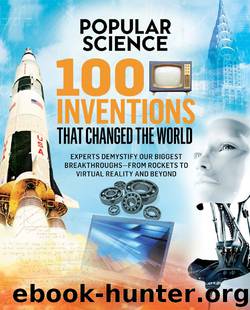100 Inventions That Changed the World by Popular Science

Author:Popular Science
Language: eng
Format: epub
Publisher: Weldon Owen
Wheel
Many inventions lay claim to being the most important of their time. But few have altered the course of civilization as much as the wheel.
Simply put, a wheel is a circular object with a hole in the center, designed to rotate on a fixed axle. Historians debate whether the wheel was invented in a single place and then spread to other regions around the globe, or if it came into use at the same time in various places. There is evidence to support the origin of the wheel in both Mesopotamia (present-day Iraq) and the Eurasian steppes.
Surprisingly, the wheel did not start off as a means of transportation. Most historians believe that the first wheels were for making pottery, based on a 5,500-year-old Mesopotamian wheel. Farming, boats, musical instruments, rope, and weaving were all common approximately 3500 B.C.E. when the wheel was used to move people and goods from place to place.
Humans first developed the sled as a means of carrying heavy loads and later placed it atop round logs, making the load easier to pull. The wheelbarrow evolved from this apparatus: The round logs developed grooves, reducing the friction from the sled on top, making the turning motion easier, and the sled gave way to the wheelbarrow with moving axles and wheels.
During the following period, known as the Bronze Age (c. 3000 B.C.E.), new metal tools allowed craftsmen to create fixed axles sized with great precision that fit into the smooth, round hole at the center of the wheel, maintaining the right amount of friction and support to allow the wheel to move easily and rapidly. Although the evolution of the wheel’s design was complete, transportation was still mainly relegated to camels, since they traveled more easily over the sand and uneven roads of the desert region.
The wheel later became important to farming and other growing trades, serving as a catalyst for migration and eventually the Industrial Revolution. Few inventions from that time are still in use today and certainly none are as ubiquitous as the wheel.
Download
This site does not store any files on its server. We only index and link to content provided by other sites. Please contact the content providers to delete copyright contents if any and email us, we'll remove relevant links or contents immediately.
| Coloring Books for Grown-Ups | Humor |
| Movies | Performing Arts |
| Pop Culture | Puzzles & Games |
| Radio | Sheet Music & Scores |
| Television | Trivia & Fun Facts |
The Infinite Retina by Robert Scoble Irena Cronin(6155)
Harry Potter and the Cursed Child: The Journey by Harry Potter Theatrical Productions(4439)
The Sports Rules Book by Human Kinetics(4290)
Molly's Game: From Hollywood's Elite to Wall Street's Billionaire Boys Club, My High-Stakes Adventure in the World of Underground Poker by Molly Bloom(3485)
A Knight of the Seven Kingdoms by George R R Martin(3190)
Quidditch Through the Ages by J.K. Rowling(3062)
How To by Randall Munroe(3031)
Flowers For Algernon by Daniel Keyes(3019)
Quidditch Through the Ages by J K Rowling & Kennilworthy Whisp(2927)
Quidditch Through the Ages by Kennilworthy Whisp by J.K. Rowling(2812)
Stacked Decks by The Rotenberg Collection(2810)
Quidditch through the Ages by J. K. Rowling(2768)
Quidditch Through The Ages by J. K. Rowling(2729)
776 Stupidest Things Ever Said by Ross Petras(2693)
Ready Player One: A Novel by Ernest Cline(2647)
What If?: Serious Scientific Answers to Absurd Hypothetical Questions by Randall Munroe(2637)
Beautiful Oblivion by Jamie McGuire(2569)
The Book of Questions: Revised and Updated by Gregory Stock Ph.d(2516)
Champions of Illusion by Susana Martinez-Conde & Stephen Macknik(2414)
